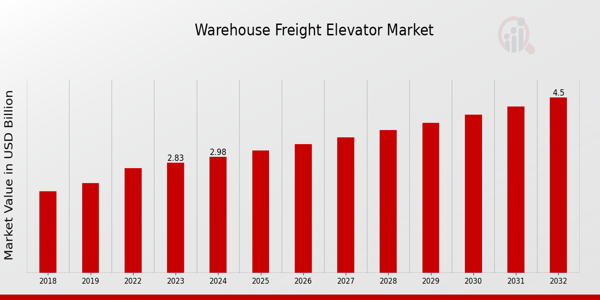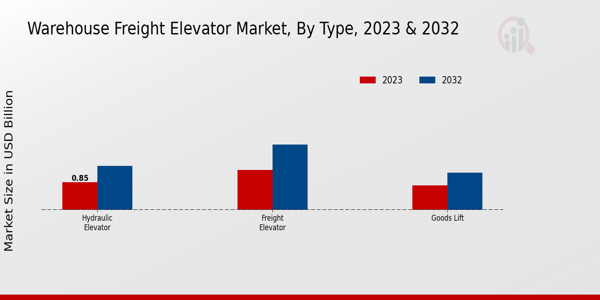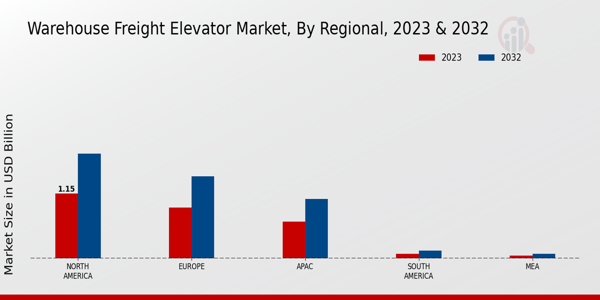Global Warehouse Freight Elevator Market Overview
The Warehouse Freight Elevator Market Size was estimated at 3.14 (USD Billion) in 2024. The Warehouse Freight Elevator Industry is expected to grow from 3.31 (USD Billion) in 2025 to 5.28 (USD Billion) by 2034, at a CAGR (growth rate) is expected to be around 5.3% during the forecast period (2025 - 2034)
Key Warehouse Freight Elevator Market Trends Highlighted
The Warehouse Freight Elevator Market is primarily driven by the growing demand for efficient logistics and the need for streamlined material handling in warehouses. As e-commerce continues to expand, companies are seeking faster and more effective ways to transport goods within facilities. Additionally, the increasing focus on optimizing space in urban areas drives the need for advanced freight elevators, which can enhance vertical transportation efficiency. As businesses aim to improve operational efficiency, investing in modern freight elevator systems becomes a strategic priority. There are several opportunities to be explored in the market.The integration of smart technology, such as IoT and AI, presents a chance for manufacturers to develop advanced freight elevator systems that offer real-time monitoring and predictive maintenance. This technology can reduce downtime and improve overall safety. Furthermore, as sustainability becomes a growing concern, developing energy-efficient elevator solutions could attract environmentally conscious businesses. There is also potential for expansion into emerging markets where the logistics sector is rapidly growing, and modernization efforts are underway. In recent times, there has been a noticeable trend toward automation and the use of automated guided vehicles in conjunction with freight elevators to create seamless logistics solutions.Companies are increasingly adopting multi-tiered systems that combine storage and transportation, minimizing manual labor and improving speed. The demand for customizable solutions has also surged as businesses seek elevators that can be tailored to their specific needs and facility layouts. The shift towards smart warehouses is reshaping the market, allowing for more interconnected operations and maximizing the use of available space while addressing the challenges posed by growing urbanization. This evolving landscape indicates a promising future for the Warehouse Freight Elevator Market.

Source: Primary Research, Secondary Research, MRFR Database and Analyst Review
Warehouse Freight Elevator Market Drivers
Increasing Demand for Efficient Logistics and Supply Chain Management
The Warehouse Freight Elevator Market Industry is on an upward trend owing to the increasing requirement for logistical and supply chain solutions in the current world. With the global proliferation of e-commerce, firms are increasingly concerned with enhancing their warehouse practices to address the rising quantities of various products. This includes the need for quick and efficient movement of products within warehouses, which is where freight elevators play a crucial role.The ability to transport heavy loads between different levels of storage without manual handling not only boosts operational efficiency but also enhances worker safety. As businesses invest in automation and modern technologies to streamline their supply chains, the demand for advanced material handling equipment such as freight elevators is set to rise. Moreover, the shift towards vertical storage in urban areas due to space constraints is further propelling the necessity for warehouse freight elevators, as they facilitate the effective use of available vertical space.Consequently, the increased emphasis on logistics efficiency and the evolving landscape of warehousing are key drivers likely to contribute to the growth of the Warehouse Freight Elevator Market.
Technological Advancements in Elevator Systems
Another prominent driver for the Warehouse Freight Elevator Market Industry is the continuous technological advancement in elevator systems. Innovations such as smart controls, energy-efficient designs and enhanced safety features are making freight elevators more appealing to warehouse operators. Advanced technologies contribute to more reliable operations, reducing downtime, which is pivotal for maintaining productivity in modern warehouse environments.As businesses prioritize automation and smart solutions, these upgraded systems are becoming essential for maintaining competitive advantages in increasingly complex supply chains.
Growth of Online Retailing and E-commerce
The rise of online retailing and e-commerce is significantly influencing the Warehouse Freight Elevator Market Industry. With consumers increasingly opting for online shopping, the demand for warehouses to store and distribute products has surged. This boom in e-commerce necessitates efficient material handling systems, including freight elevators, that can support the quick turnover of goods and improve overall warehouse efficiency. As retail continues to shift towards online platforms, the need for robust infrastructure capable of handling high volumes of products will drive the growth of the freight elevator market in warehouses.
Warehouse Freight Elevator Market Segment Insights
Warehouse Freight Elevator Market Type Insights
The Warehouse Freight Elevator Market is a vital segment of the broader logistics and transportation industry, with a valuation of 2.83 USD Billion in 2023, projected to grow substantially by 2032. This market can be segmented into several key types, namely Hydraulic Elevator, Freight Elevator and Goods Lift, each playing a significant role in enhancing warehouse operations. The Hydraulic Elevator is expected to hold a considerable market share with a valuation of 0.85 USD Billion in 2023, rising to 1.35 USD Billion in 2032, highlighting its importance due to its space-saving design and efficient performance in moving goods vertically.The Freight Elevator, dominating the market with a valuation of 1.23 USD Billion in 2023 and anticipated to reach 2.0 USD Billion by 2032, serves the critical need for transporting large volumes of goods safely and swiftly, making it a preferred choice in large warehouses and distribution centers. In terms of market dynamics, the Goods Lift holds a valuation of 0.75 USD Billion in 2023, projected to grow to 1.15 USD Billion by 2032, representing its niche application in handling lighter loads, which is essential for specialized warehouse operations.As the demand for efficient material handling surges, driven by e-commerce growth and increased warehousing activities, the Warehouse Freight Elevator Market is poised for steady growth. The trends in automation and technological advancements present opportunities yet pose challenges to maintaining standards in safety and regulations. Overall, the market statistics reflect a continuously evolving landscape where innovation and reliability remain pivotal for stakeholders, ensuring efficient logistics and operational excellence across the supply chain.

Source: Primary Research, Secondary Research, MRFR Database and Analyst Review
Warehouse Freight Elevator Market Load Capacity Insights
The Load Capacity segment is crucial in catering to different logistical requirements, allowing warehouses to transport varying weights efficiently. The categories of Less than 2000 kg, 2000 kg to 4000 kg, and More than 4000 kg highlight significant market diversity. Notably, the capacity of less than 2000 kg holds major importance as it is commonly utilized for lighter goods, facilitating ease of movement in smaller facilities.Meanwhile, the 2000 kg to 4000 kg range offers enhanced flexibility for medium-sized operations, addressing a broader spectrum of inventory types. The More than 4000 kg capacity caters predominantly to heavy-duty applications, dominating segments that handle substantial loads, such as automotive components and industrial equipment. The continuous expansion of e-commerce and inventory management trends propels market growth, while challenges include maintaining safety and efficiency across varying load capacities. Opportunities lie in developing advanced technologies to optimize elevator performance and reduce operational downtime within the Warehouse Freight Elevator Market industry, providing relevant data for stakeholders aiming to enhance their logistics capabilities.
Warehouse Freight Elevator Market End Use Insights
With a steady growth trajectory, the market caters to critical sectors such as Warehouse, Retail and Manufacturing. The Warehouse segment plays a crucial role in facilitating the efficient movement of goods, which is essential for maintaining supply chain productivity. Retail also holds substantial importance, as elevated freight systems enhance logistics capabilities in stores, contributing to better customer experience.Manufacturing, on the other hand, dominates due to the need for heavy lifting and efficient material handling, ensuring streamlined production processes. Overall, the market growth is fueled by increasing demand for automated systems, rising urbanization, and the expansion of e-commerce, while challenges such as high installation costs and space constraints present hurdles. Nevertheless, opportunities abound as advancements in technology push for smarter and more efficient freight elevator solutions. The Warehouse Freight Elevator Market Statistics reflect a strong potential for growth driven by these industries.
Warehouse Freight Elevator Market Control System Insights
This segment is essential for ensuring smooth logistics and material handling processes in warehouses. The landscape includes Manual Control, Semi-Automatic Control and Fully Automatic Control, each serving different operational needs. Manual Control allows for direct operator engagement, making it suitable for smaller operations, while Semi-Automatic Control combines human intervention with automated processes, offering a balance of control and efficiency.Fully Automatic Control, dominating the industry, enhances productivity by minimizing human involvement, making it vital for large warehouse systems that require high throughput. Trends such as increasing demand for automation in logistics and the need for energy-efficient systems are driving growth. Factors such as the growing emphasis on workplace safety and technological advancements present opportunities, while challenges may arise from integration complexities and the high initial setup costs. The Warehouse Freight Elevator Market data reflects ongoing innovations that cater to a diverse range of operational complexities within this segment.
Warehouse Freight Elevator Market Installation Type Insights
The installation type segment comprises critical components such as new installation, modernization and maintenance and repair services, each playing a vital role in supporting the efficiency of warehouse operations. New installations are significant as they cater to the increased demand for automated systems within warehouses, enabling enhanced operational efficiency. Modernization is also crucial, allowing facilities to upgrade and adapt their existing freight elevators to current technological standards, thereby improving energy efficiency and safety.Maintenance and repair services ensure operational reliability and reduce downtime, reinforcing their importance in realizing the overall market potential. The trends in this segment indicate a notable shift towards automation and integrated technology solutions, driving the Warehouse Freight Elevator Market revenue while emphasizing the necessity for continuous service and support. With a healthy compound annual growth rate projected until 2032, these factors collectively underline the evolving landscape of the market. The segmentation and insights gathered about the Warehouse Freight Elevator Market data reveal a robust framework that addresses growing requirements in the industry.
Warehouse Freight Elevator Market Regional Insights
North America leads with a valuation of 1.15 USD Billion in 2023, highlighting its majority holding due to robust logistics and warehouse infrastructures, expected to reach 1.85 USD Billion by 2032. Europe follows closely, valued at 0.90 USD Billion in 2023, benefitting from advanced technologies in freight handling and anticipated growth to 1.45 USD Billion by 2032. The APAC region, valued at 0.65 USD Billion, demonstrates significant growth potential, expected to rise to 1.05 USD Billion, driven by burgeoning e-commerce and rapid urbanization.South America and MEA are smaller segments, valued at 0.08 USD Billion and 0.05 USD Billion, respectively, in 2023, though they present opportunities for growth, reaching 0.14 USD Billion and 0.08 USD Billion by 2032. The Warehouse Freight Elevator Market statistics indicate that while North America and Europe dominate, APAC's rapid expansion showcases emerging opportunities, with market growth influenced by increasing demands for efficient logistics solutions.

Source: Primary Research, Secondary Research, MRFR Database and Analyst Review
Warehouse Freight Elevator Market Key Players and Competitive Insights
The Warehouse Freight Elevator Market is characterized by its dynamic competitive landscape, driven by the increasing demands of the logistics and warehousing sector. As global trade expands, the need for efficient material handling solutions has become crucial for businesses aiming to optimize their operations. This has led to a surge in the adoption of warehouse freight elevators, which facilitate the transportation of goods between different levels of a facility. Various players operate within this market, each vying for market share by enhancing their product offerings, improving service quality, and adopting innovative technologies. Companies are focused on expanding their geographical reach and catering to a diverse customer base, aiming to differentiate themselves through various strategies such as pricing, product features, and after-sales support.Genuine Elevator has established itself as a significant player within the Warehouse Freight Elevator Market, known for its commitment to quality and innovation. The company offers a diverse range of freight elevators engineered specifically for warehouse environments, incorporating advanced technology that enhances performance and reliability. One of the key strengths of Genuine Elevator lies in its robust manufacturing capabilities, allowing for tailored solutions to meet the unique logistical challenges faced by clients. Their focus on durability and safety standards ensures their products can handle heavy loads, thereby maximizing efficiency in warehousing operations. Furthermore, Genuine Elevator's strong emphasis on customer service and technical support reinforces its reputation, enabling clients to maintain operational continuity with minimal downtime.Xizi Otis is another prominent competitor in the Warehouse Freight Elevator Market, recognized for its strong presence and extensive experience in the industry. The company is known for its innovation-driven approach, integrating cutting-edge technology into its freight elevator solutions to enhance efficiency and performance. Xizi Otis leverages its global footprint to cater to a vast array of clients in various industries, making its products a preferred choice for modern warehouses. The company's strengths include its ability to rapidly deploy solutions across different markets and its comprehensive maintenance services, which ensure that systems operate smoothly over time. Xizi Otis continues to invest in research and development to stay ahead in a competitive market, focusing on sustainable solutions that meet the evolving needs of warehouse operators.
Key Companies in the Warehouse Freight Elevator Market Include
- Genuine Elevator
- Xizi Otis
- Fujitec
- Otis
- KLEEMANN
- Kone
- Hitachi
- Mitsubishi Electric
- Blain
- Thyssenkrupp
- Groupe Schindler
- Stannah
- Schindler
- Toshiba
Warehouse Freight Elevator Market Industry Developments
Recent developments in the Warehouse Freight Elevator Market indicate a dynamic shift as companies like Kone, Mitsubishi Electric, and Thyssenkrupp enhance their product offerings to meet increased demand driven by e-commerce growth. In particular, Genuine Elevator has made headlines with its focus on innovation, introducing energy-efficient models that align with sustainability goals. Meanwhile, Hitachi has leveraged advancements in IoT technology to improve supply chain efficiencies through smarter freight elevator systems.
Notably, there have been reports of strategic collaborations among major players to expand market reach. Otis and Schindler continue to strengthen their positions by incorporating automation into their freight elevator designs. However, there have been no significant recent mergers or acquisitions involving the listed companies. The ongoing enhancement of technologies and services is propelling growth in market valuation, benefiting stakeholders across various sectors. As logistics and warehouse capabilities evolve, companies such as Fujitec and KLEEMANN are prioritizing the integration of digital solutions to maintain competitiveness. This environment emphasizes the necessity for continual innovation, prompting firms to adapt and reinforce their market positions effectively.
- Warehouse Freight Elevator Market Segmentation Insights
- Warehouse Freight Elevator Market Type Outlook
- Hydraulic Elevator
- Freight Elevator
- Goods Lift
- Warehouse Freight Elevator Market Load Capacity Outlook
- Less than 2000 kg
- 2000 kg to 4000 kg
- More than 4000 kg
- Warehouse Freight Elevator Market End Use Outlook
- Warehouse
- Retail
- Manufacturing
- Warehouse Freight Elevator Market Control System Outlook
- Manual Control
- Semi-Automatic Control
- Fully Automatic Control
- Warehouse Freight Elevator Market Installation Type Outlook
- New Installation
- Modernization
- Maintenance and Repair
|
Report Attribute/Metric
|
Details
|
|
Market Size 2024
|
3.14 (USD Billion)
|
|
Market Size 2025
|
3.31 (USD Billion)
|
|
Market Size 2034
|
5.28 (USD Billion)
|
|
Compound Annual Growth Rate (CAGR)
|
5.3 % (2025 - 2034)
|
|
Report Coverage
|
Revenue Forecast, Competitive Landscape, Growth Factors, and Trends
|
|
Base Year
|
2024
|
|
Market Forecast Period
|
2025 - 2034
|
|
Historical Data
|
2020 - 2024
|
| Market Forecast Units |
USD Billion |
| Key Companies Profiled |
Genuine Elevator, Xizi Otis, Fujitec, Otis, KLEEMANN, Kone, Hitachi, Mitsubishi Electric, Blain, Thyssenkrupp, Groupe Schindler, Stannah, Schindler, Toshiba |
| Segments Covered |
Type, Load Capacity, End Use, Control System, Installation Type, Regional |
| Key Market Opportunities |
1. Rising e-commerce logistics demand, 2. Increasing automation in warehouses, 3. Growing urbanization and infrastructure development, 4. Enhanced safety regulations and standards, 5. Technological advancements in elevator systems |
| Key Market Dynamics |
1. Growing e-commerce demand, 2. Technological advancements, 3. Safety regulations compliance, 4. Increased construction activities, 5. Sustainable design trends |
| Countries Covered |
North America, Europe, APAC, South America, MEA |
Frequently Asked Questions (FAQ) :
The Warehouse Freight Elevator Market is expected to reach a value of 5.28 USD Billion by 2034.
The projected CAGR for the Warehouse Freight Elevator Market from 2025 to 2034 is 5.3%.
North America is expected to have the largest market share, projected to reach 1.85 USD Billion in 2032.
The Hydraulic Elevator segment is projected to be valued at 1.35 USD Billion in 2032.
The Freight Elevator segment is expected to reach a market value of 2.0 USD Billion in 2032.
The Goods Lift segment is projected to be valued at 1.15 USD Billion in 2032.
Major players in the market include Genuine Elevator, Kone, Mitsubishi Electric and Thyssenkrupp.
The market value for the Europe region is expected to reach 1.45 USD Billion in 2032.
Key growth drivers include increasing logistics demands and advancements in elevator technologies.
The APAC region is anticipated to grow significantly, projected to reach a market value of 1.05 USD Billion by 2032.

















